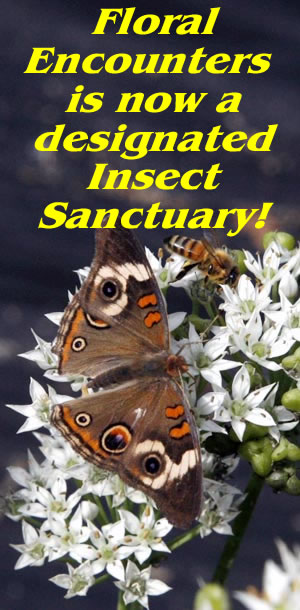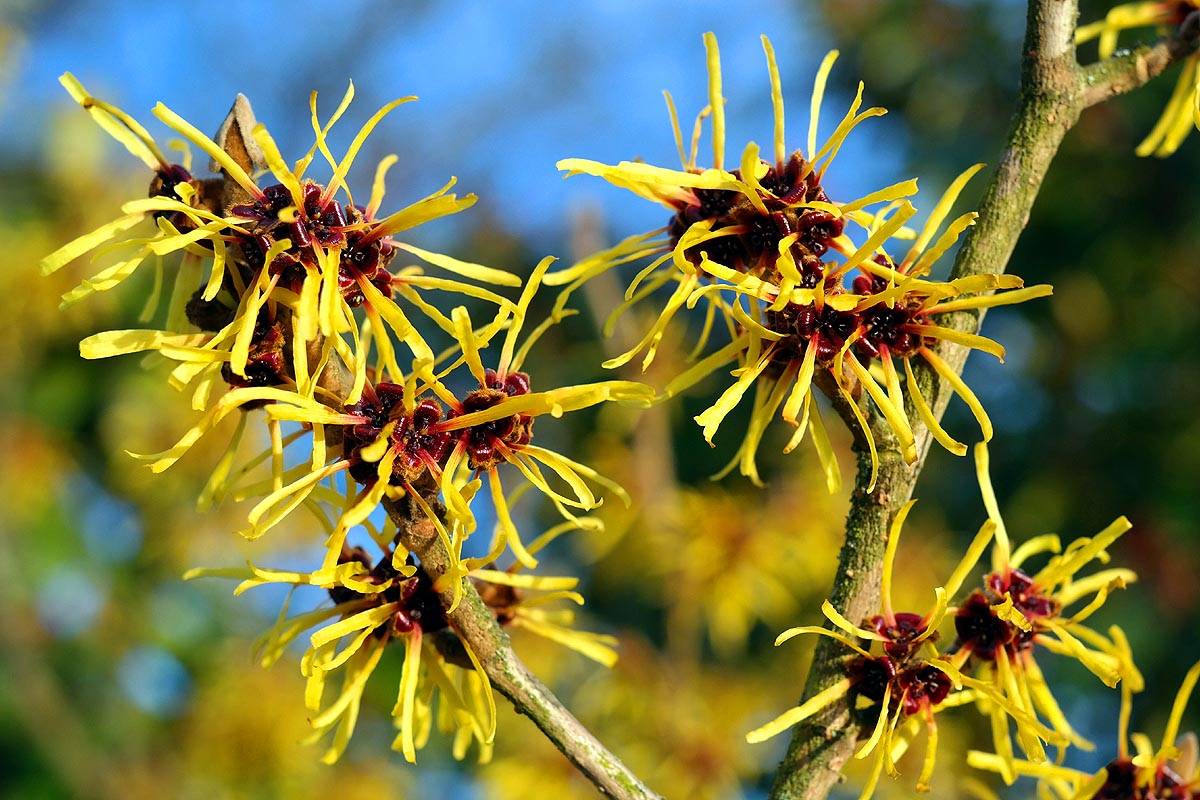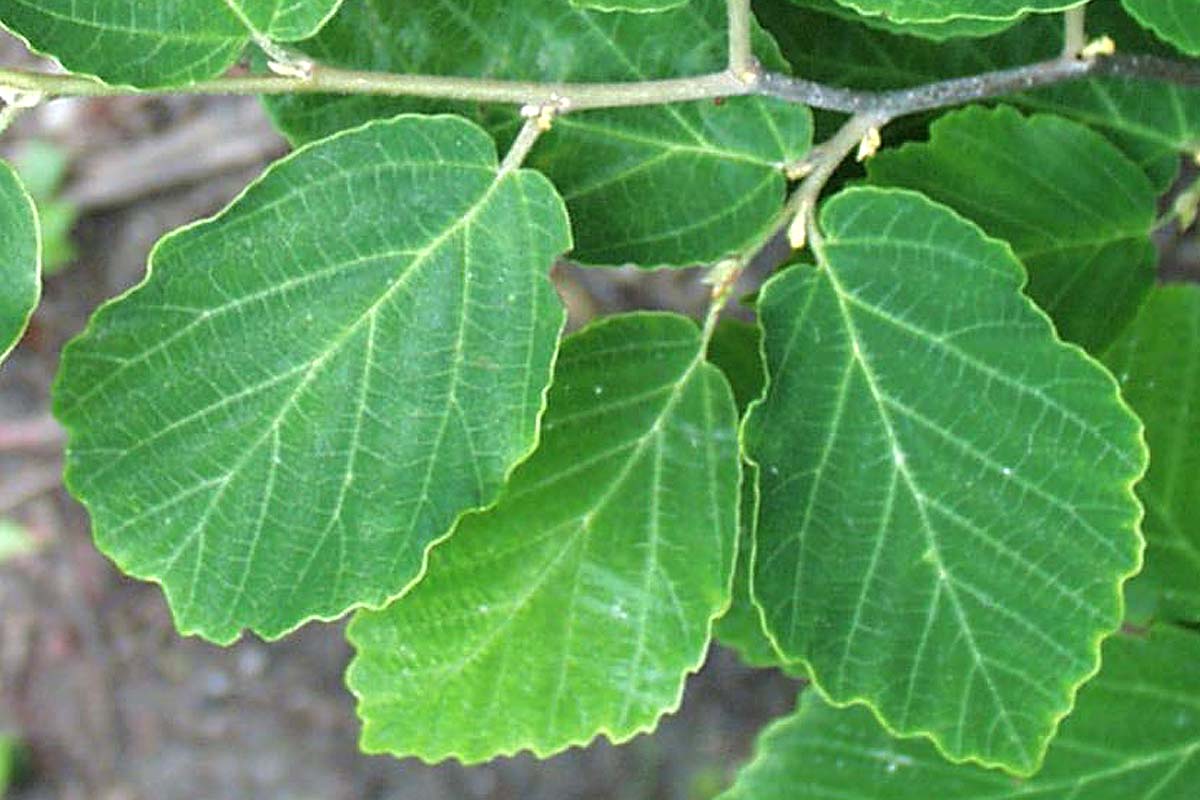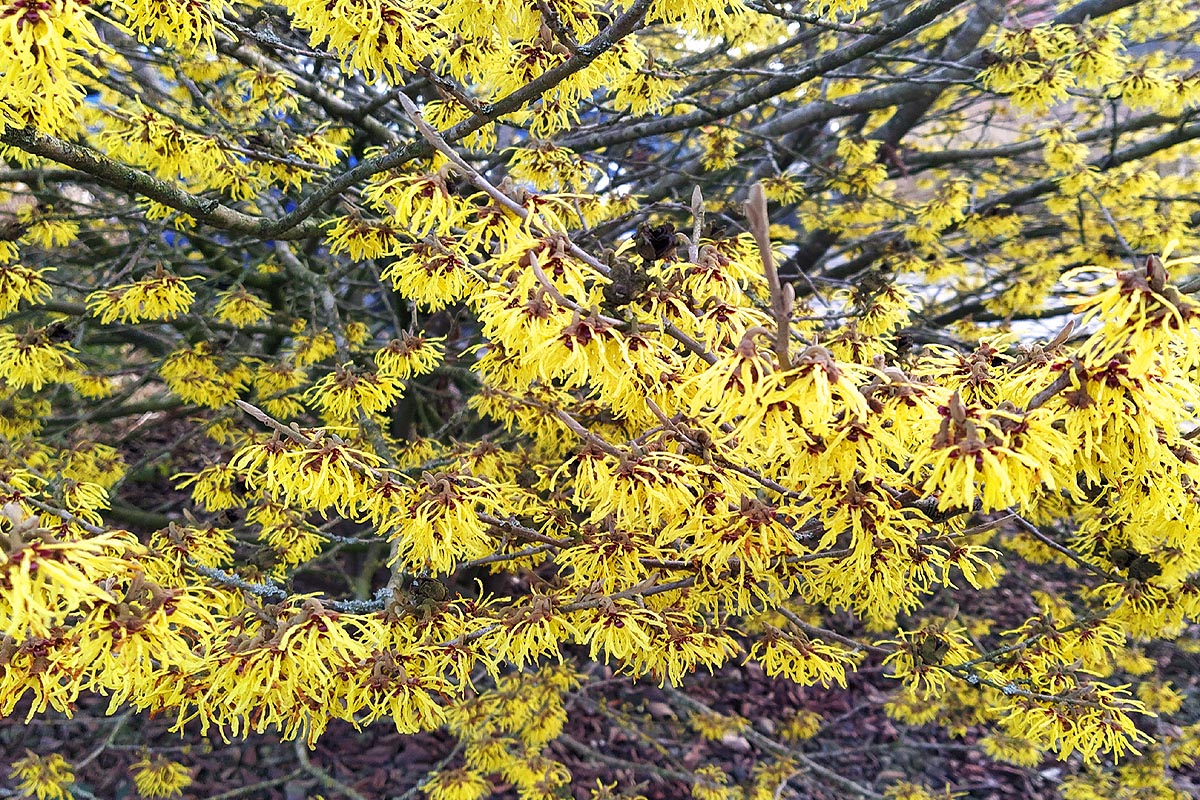Witch hazel is a lovely North American Native that blooms in the winter months. The yellow tassel like flowers are borne on the bare branches turning them into shaggy golden boughs that flutter in the breeze. Growing to a height on 20 feet it is classified as a shrub because of its habit of growing many trunks rather than one. The leaves and bark contain strong tannins making it distasteful for browsing animals so deer wont eat it. Those same properties also make it the most commonly used herb today with bottles of distillate sold in almost every pharmacy and incorporated into many commercial products. Seeds are fussy and require specific warm cold cycles before they will germinate, but the wait is worth it and shrubs grow from zone 3 down to 8 full sun in the north more shade in the south. Early blooming is important to many birds and insects looking for winter foods and the joy of having flowers blooming in the snow makes the winter seem more joyful.
This is a deciduous plant to the flowers appear in clusters on bare branches. Each flower consists of four long thin bright yellow petals about 1/2-3/4 inch (1.2-2.0cm) long ending in a small red calyx. These flower clusters along the branches give the shrub a shaggy appearance and a rich food source for winter flying insects and some birds. The flowers are very fragrant with a sweet lemon zesty type aroma. Flowers are adapted to winter cold and curl up when temperatures drop below freezing, then unroll again when they warm. They will remain blooming for long periods of time anywhere from 6-12 weeks or more and are often still present when the leaves are fully formed.
Leaves are simple ovate with a very slight point. The margins are lightly but erratically serrated often described as wavy due to the deeply veined leaves appearing rather sculpted. Leaves are 3-6 inches (7-15cm) long with a slightly rough texture. They begin as spring green turn darker mid green for most of the season and finally a beautiful vibrant yellow in autumn/fall. Although in some areas the leaves are more a bright orange yellow.
The fruits capsules are hidden amongst the leaves and resemble tiny woody fruits or even just knobbles on the branches. The remain on the plant for over a year as the seeds do not ripen for almost a full year. after the flowers bloom. This is due to the interesting dispersal method. The woody capsules dry in the winter breeze and then suddenly split and forcibly eject the seeds at over 20 mph (32 kmp) sending seeds over 30 feet (9m) from the parent plant which could not be achieved if leaves were still on the shrub.
Witch Hazel is considered as a shrub since its natural form is many trunked it can be pruned to a single trunk but it is not common. Its branches grow slightly twisted giving it an interesting appeal when no leaves are present and a full screening appearance when in leaf which is why it is commonly used as a windbreak or screen. Growing to the height of about 20 feet (6m) with a similar spread it can under ideal conditions grow larger.
Witch hazel also produces substance that inhibit the germination of other plants under its canopy to increase nutrient availability are reduce competition. These substances are also repellent to deer and other browsing animals which tend to leave it alone. This can be beneficial for the home owner as there are less competing weeds. Hardy from zone 3-8.
Growing Witchhazel (Hamamelis virginiana) from Seed.
This one is a challenge but its well worth the work. The bad news is that it can take up to two years for the seeds to germinate. Since Witch hazel is used commercially a great deal of research has been done on the best and fastest way to get these seeds to sprout. This seed needs periods of different temperatures before it 'wakes up'. A period of warm then cold then warm and cold again. In some instances some seeds can be fooled into sprouting after just one warm cold cycle but most remain stubbornly in the whole cycle. The good news is we can fool them into germinating faster by using artificial methods. Its still slow but its less than two years.
2. Place seeds in a container filled with STERILE seeding mix. Transfer seeds using sterile implements or one time use plastic gloves. Cover the seeds with a layer of sterile compost and dampen with boiled water. Place a lid on the box and keep at room temperature for 4 months. Label it so you know what is in there. The elaborate method is to help prevent mold spores from landing in the box and causing issues. If possible do this step in winter or early spring when mold spores are low. Ensure the soil stays just slightly moist, not wet.
3. After your warm period is over put the box in the refridgerator for 3 months. Monitor at all times for mold growth. If found remove seeds and replace with new sterile soil.
4. Now finally the seeds are ready for planting. Remove from the refridgerator and sow as any other seed but keep in warm not hot area, do not place on a heating pad. Keep in regular to shady light not high level grow lights. Plant in small individual pots for easy monitoring and ensure they dont dry out.
We recommend using a small plastic food box easily obtainable from most supermarkets. Shallow transparent ones are idea. Fill with sterile seeding mix, add seeds water and put the lid on. The transparent sides will allow you to monitor for mold without removing the top and possibly introducing more mold spores. If the lid is fixed correctly it should not need removing to add water until after the period in the refridgerator is completed. Make sure you label the box well and keep it upright do not shake.
Some seeds should germinate within 30 days others make take longer. Do not give up on pots that dont, place outside in an shady are and keep moist some seeds are stubborn and may not germinate for another year.
Keep small plants in semi shaded are as they grow, not until they are 4-6 inches (10-15cm) should they be exposed to full sun. The amount of sun exposure will be determined by your location. Transplant to final location under cloudy skies when plants reach 6-10 inches (15-25cm) tall.
Direct planting.
Otherwise just plant the seeds where you want the shrubs to grow. Mark the spot, ensure it never dries out and wait for nature to do the work. Just remember where you planted the seeds and dont over dig the area, plant something else in it, or worse pull up the seedings when they germinate because you forgot you planted them there!
Location is going to depend on your zone. For those in colder zones meaning mostly that they are more northern light levels are lower so full sun is recommended. Moving south as light levels increase more shade needs to be provided. In zones 5-7a partial shade, woodland edges, north sides of structures are ideal. Some shade from noon sun is recommended.
7b and 8 its best grown as an understory plant with taller shade trees or in a shaded location that also has good airflow. South Eastern United States may have issues with mold and fungus as it does not do well in humid conditions so good airflow around the plant will be essential. Some pruning to ensure that there is not a lot of moist trapped air in the center of the plant will also help with this.
Water. It prefers a reasonable amount of water and in the wild will usually be found close to a water source of some kind. Very tolerant of heavy soils even heavy clay but soil must drain does not tolerate swamp of standing water. Will not grow well at all on dry arid soils.
If soil is not to its liking adding large amounts of compost to increase water retention while also allowing it to drain is the best solution.
While some state that its fairly drought tolerant once established this is disputed by many and suggested that shrub has found deeper water source.
Soil type. Very tolerant of heavy soils and even heavy clay but soil must at some point drain. Does not like standing water, swamps or areas that flood on a regular basis. However soils that retain some water are favored and does not do well in sandy soils unless its near a water source.
Its fairly adaptable as provided soil is not wildly acidic should grow reasonably well.
May need additional water if planted in sandy well draining soil. Add more compost to enrich soil and hold in water. In poor soils some liquid fertilizer or tree spikes are recommended to add nutrients. Mulching in late fall with chopped leaves helps provide fertilizer for the following year.
The early flowering however is extremely beneficial to many species of insect that are looking for food during the colder months and on warm days bees and other pollinators are often found crowding the blooms.
Birds often nest in the branches since the tree has such astringent leaves some predators avoid it.
Its use was quickly adopted by the west and today its still an extremely important herb and a distillate of the bark is generally available in almost every pharmacy in the country. Witch hazel is very astringent and the distillate is used externally to treat bruises, sore muscles, varicose veins, hemorrhoids, sore nipples, inflammations. It is also used in many proprietary eye drops, skin creams, ointments and skin tonics. Research has suggested that the tannins in the bark are responsible for the astringent properties of this herb but the steam distillate commercially available does not contain these so its actions are much weaker than if prepared as a tincture or collected as the first distillation used in commercial preparations.
Internally as a tincture it is used to treat colitis, dysentery, hemorrhoids, diarrhea, , piles, vaginal discharge, excessive menstruation, internal bleeding, varicose veins and prolapsed organs
The leaves also contain the same compounds but in much lower amounts. infusions of the leaves are used to treat internal hemorrhages and piles and externally for all kinds of inflammations including the eye.
Other uses of Witchhazel (Hamamelis virginiana).
Rootstocks are commonly used to graft other ornamental species as they are so robust. Branches can be cut early and brought in as flower decorations.
The most interesting use is for the art of dowsing. This involves using a forked twig or two twigs with right angle bends to find underground objects most commonly water and minerals. This practice was common beginning in Europe from the early 15th century and is usually performed using common Hazel twigs.
Some sources suggest that the practice originated in North American where native tribes would use Witch hazel to find water and then exported the craft back to Europe where the use was transferred to a different plant. This appears to be suggestion only and no proof of this statement has been found.











